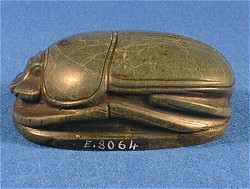
Amulet usually shaped like a scarab, or else with a scarab on the top and a heart, as perceived by the ancient Egyptians, on the reverse - a sort of vase with handles. From the late New Kingdom, there are also heart amulets shaped only like a heart, and not like a scarab. Some heart scarabs also show the head of the deceased. The common idea that the heart scarab was designed to replace the heart after its removal at mummification is incorrect. The Egyptians feared that the heart, the seat of memory and conscience, would testify against the deceased at the Divine Tribunal. Placing a heart scarab in the mummy bandages or around the neck of the deceased was designed to prevent this. They are often inscribed with a spell from the Book of the Dead imploring the heart not to abandon its owner. Among other things, the heart is called 'heart of my form' (kheperu in Egyptian). Because the scarab was called kheper in ancient Egyptian, some scholars have interpreted the similar sound as the reason why the amulet usually had the shape of a scarab. Ancient Egyptian texts clearly state, however, that the notion of rebirth (kheper also means 'to come into being'), linked with the resurrected sun Khepry, played as much of a role as the deceased's wish, dictated by his heart, to be able to transform himself into any form he wants. According to the Book of the Dead, the amulet had to be made of carnelian, but in practice there are many examples made of faience, steatite, glass and other materials.